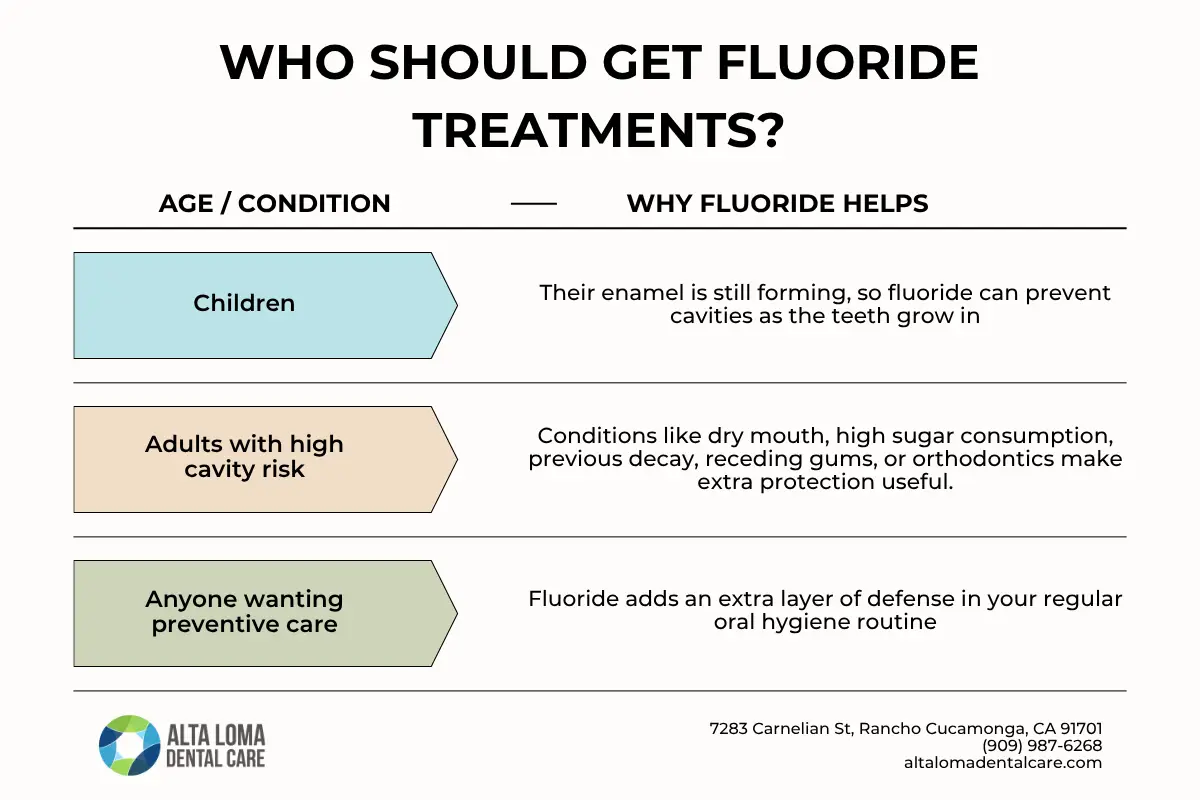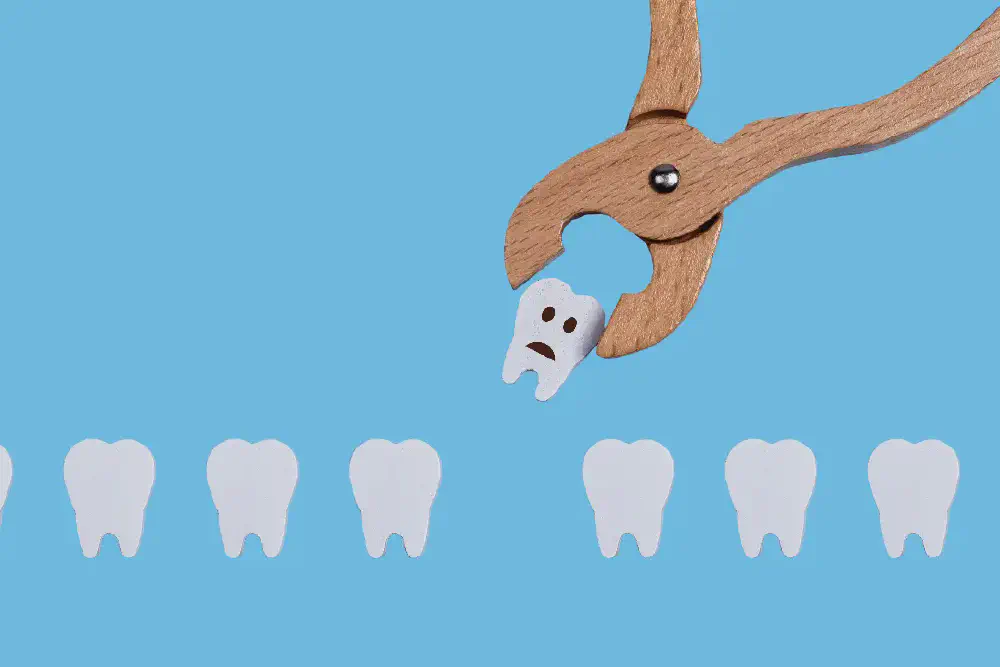Looking for a “fluoride treatment near me”? You’re making a smart choice for your oral health.
In this post, we’ll explain how fluoride works, who benefits most, what to expect during treatment, and tips to maximize the protection. If at the end you want to brighten your smile too, don’t forget to check out our teeth whitening service.
Ready to protect your smile? Book your fluoride treatment appointment with our Alta Loma dental team today — conveniently located near Alta Loma High School and Stater Bros. Market on Baseline Rd so you can find us easily.
What Is Fluoride & Why It Matters
Fluoride is a naturally occurring mineral that plays a key role in dental health. When applied or ingested in the right amounts, fluoride:
- Strengthens tooth enamel and makes it more resistant to acid attack from bacteria and sugars.
- Helps reverse early decay by remineralizing weakened areas before cavities fully form.
- Inhibits bacterial activity in plaque, reducing acid production
Who Should Get Fluoride Treatments?
Fluoride treatments aren’t just for kids — people of all ages can benefit, although some groups get more relative benefit:

What to Expect During a Fluoride Treatment
Here’s a typical process:
- Dental exam / cleaning: Your dentist or hygienist examines your teeth, cleans off plaque, and assesses your risk.
- Choose the form: Fluoride may be applied as a varnish (painted on), gel, foam, or via trays that hold fluoride against the teeth.
- Application: Depending on the method, you may hold trays for 1–4 minutes, or the varnish is painted on and sets quickly.
- Post-treatment instructions: You’ll likely be asked to avoid eating, drinking, brushing, or flossing for 30 minutes (or longer) so fluoride can fully absorb.
Overall, the procedure is quick, painless, and often done during your regular dental visit.
Safety & Side Effects
When used appropriately, fluoride treatment is very safe. However:
- Excessive fluoride intake (especially in young children) can cause fluorosis (white spots or streaks on teeth).
- Because professional fluoride uses a higher concentration, it’s important that dentists supervise its use, especially in children.
- Always inform your dentist if you have special health conditions (kidney issues, allergies) or are pregnant.
How Often Do You Need Fluoride?
The ideal frequency depends on your risk of decay:
- For many patients, every 6 months during routine visits is sufficient.
- If you’re high-risk (history of cavities, dry mouth, orthodontics, etc.), your dentist may recommend every 3 to 4 months.
Your dentist will tailor the schedule to your oral health profile.
Cost Considerations & Insurance
- Fluoride treatments (office-applied) often cost in the range of $20–$50 depending on location and clinic. Dental Care Associates
- Many insurance plans cover preventative fluoride treatments for children; coverage for adults is less consistent
- Some clinics bundle fluoride with cleaning visits — check with your local provider.
Maximize the Benefits of Fluoride
To get the most out of fluoride treatment:
- Use a fluoride toothpaste (standard in many markets) for daily reinforcement
- Drink fluoridated water if available in your area
- Limit sugary snacks and drinks, which fuel acid production
- Maintain good brushing and flossing habits
- Visit your dentist regularly so early decay can be caught and managed
A Note on Cosmetic Whitening (Smile Brightening)
Fluoride protects and strengthens enamel, but if you’re also interested in improving the appearance of your smile, we offer a professional teeth whitening service.
Learn more here: Teeth Whitening at Alta Loma Dental Care
Why “Fluoride Treatment Near Me” Makes Sense
If you’re searching for fluoride treatment near me, it means you’re looking for proactive, preventive dental care close to you. A local clinic offering fluoride gives you:
- Fast access to professional care.
- The convenience of pairing fluoride with other services (cleanings, exams).
- A chance to consult with a dentist about your personal risk and oral health goals.
Frequently Asked Questions About Fluoride Treatment
1. What is a fluoride treatment, and how does it work?
Fluoride treatment is a simple procedure where a concentrated form of fluoride is applied to your teeth. It strengthens enamel, helps reverse early tooth decay, and prevents cavities by making teeth more resistant to acids.
2. Is fluoride treatment safe for children?
Yes — when applied by a dental professional, fluoride treatment is safe for kids and strongly recommended by the American Dental Association (ADA). It helps protect developing teeth and lowers the risk of cavities as children grow.
3. How often should I get fluoride treatment?
Most patients benefit from fluoride every 6 months, usually during their dental cleaning. If you’re at higher risk of decay (due to dry mouth, past cavities, braces, or gum recession), your dentist may recommend every 3–4 months.
4. How long does the procedure take?
Fluoride treatment is quick and painless, usually completed in just a few minutes at the end of your dental check-up. You may be asked to avoid eating or drinking for 30 minutes afterward.
5. Does insurance cover fluoride treatment?
Fluoride treatment is often covered for children under many dental insurance plans. For adults, coverage varies. Our team can check your plan and provide cost details before treatment.
6. How much does fluoride treatment cost if I pay out-of-pocket?
On average, professional fluoride treatments cost between $20–$50. It’s a cost-effective way to protect your teeth compared to the expense of filling cavities later.
7. Where is your clinic located?
Our office is conveniently located in Alta Loma, near [insert local landmark, e.g., “Alta Loma High School” or “Stater Bros. Market on Baseline Rd”], making it easy to stop by for your treatment.
Still have questions? Call our friendly team or book your appointment online— we’ll help you protect your smile with personalized preventive care.




